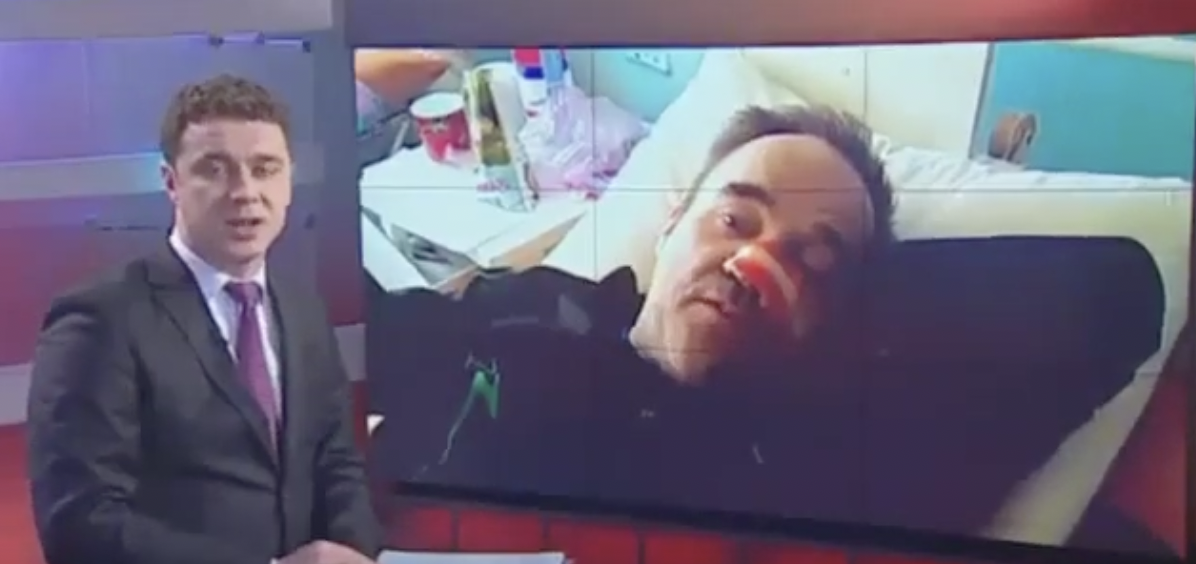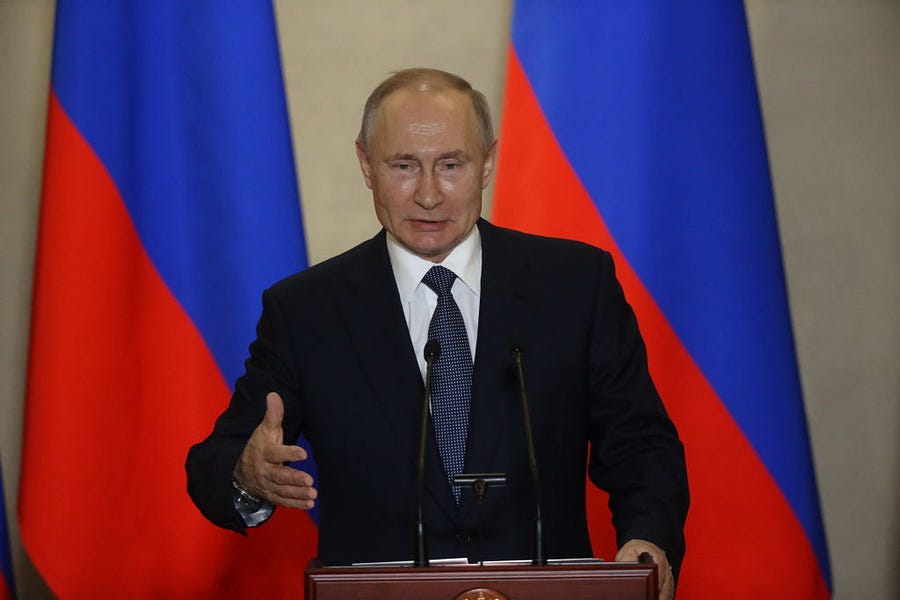Deception is an integral part of how Russia is fighting its wars, including public press pronouncements and fabricated news items. In recent weeks, U.S. and British officials have tried to flip the script on this Russian tactic by selectively releasing intelligence information to let the world know what kind of lies the Russians are planning. This is a bold new strategy to blunt Russian aggression in both the information space and in the physical world.
As part of this push, last week State Department spokesman Ned Price let the world know that Russia is planning to create a faked video of a fabricated Ukrainian atrocity in Eastern Ukraine to justify a further Russian invasion. The video would include faked gore and even fake mourners. One journalist was skeptical, and demanded further proof. He even compared the State Department’s claim to something out of InfoWars: “Crisis actors? Really? This is like Alex Jones territory you’re getting into now.” Here’s video of the awkward exchange.
Unfortunately, Price was unprepared and defensive. He should have spoken about the regular use of faked videos by Russian propagandists to support their Ukraine narratives. There have been at least six faked videos that came out of the Ukraine crisis since the war started in 2014. While these videos do not come with an easy-to-read Moscow return address, even someone without access to intelligence information can see how they fit right within Russia’s propaganda objectives. While several of them are poorly done fakes, perhaps done quickly on a shoestring budget, at least one is a pretty good imitation of reality.
Let’s start with a pretty good one: a fake video of an American getting captured in a Ukrainian uniform in Kharkiv in April 2014. To understand the timing and purpose of this video, one needs to understand the background.
In early April, Putin had stolen Crimea but had yet to invaded Eastern Ukraine. Around this time increasingly aggressive pro-Russian “protesters” appeared in major cities in Eastern and Southern Ukraine, protesters who were financed and directed by Russia, as shown by intercepted phone calls between protest leaders and Kremlin adviser Sergei Glazyev. On April 6 these “protesters” in the Ukrainian cities of Kharkiv and Donetsk stormed regional administrative buildings and declared a “Kharkiv Peoples’ Republic” and a “Donetsk Peoples’ Republic”. “Protesters” in Luhansk declared a “Luhansk People’s Republic” two days later. The Ukrainian interim government could see where this was going, and we know where it went. They started moving some elements of the Ukrainian security forces eastward to nip this rebellion in the bud.
In the early morning of April 8, the Ukrainian security forces stormed the Kharkiv regional administration and ejected the rebels. Ukrainian forces never managed to do the same in Donetsk or Luhansk, and we can see the consequences today. Also on April 8, 2014, the Russian Foreign Ministry claimed that 150 American mercenaries from the firm “Greystone” were involved in “suppressing protests” in Southeast Ukraine. The major Russian news outlet RIA Novosti reported that a “source in Ukrainian law enforcement” said that three combat units were deployed to Donetsk and Luhansk, including Blackwater mercenaries wearing the uniform of the “Sokol”, a commando unit of the Ukrainian Ministry of the interior. This story was flashed across Russian media and even repeated on RT, the English-language Russian propaganda channel.
Declaring that Blackwater or some other American mercenary/security company was involved in Ukraine would fit nicely into the Russian propaganda theme that the Ukrainian 2014 revolution was really just a Western plot. However, there was no evidence of American mercenaries in Eastern Ukraine. It would be very difficult to hide a few hundred non-Russian speaking foreigners in Eastern Ukraine, and there is no way that U.S. diplomats would have tolerated such a high-risk situation.
When there is no evidence to be had, Russian propagandists are happy to create some. On April 9 this anonymous video appeared on YouTube:
(This is not the original post, but a re-post on the following day. The original one was taken down.)
It is a faked video, shaky camera footage purportedly showing a US citizen getting captured by pro-Russian protesters in Kharkiv. The camera goes in and out of focus, the action is at night and illuminated by a few flashlights, and conveniently you never see a face, not even of the American. The “locals” shout curses and one declares, “He was the one who was shooting!” as they nab their prisoner. The “American” was dressed in the uniform of the “Sokol,” just as the Russian Foreign Ministry had said! The attackers go silent just long enough for a hoarse voice to say in English “I’m a U.S. citizen.”
This unlisted YouTube video got play across Russian social media and the original video received more than 100,000 views over two days. The original video has since been deleted, but there are plenty of copies on YouTube and in other social media.
We know this video is faked because no American mercenaries have been captured by Russian or pro-Russian irregular forces in Ukraine. There were not any teams of American commandos in Eastern Ukraine posing as Ukrainian interior ministry troops. The Russian Foreign Ministry has not commented further on this 2014 claim, and the narrative has moved on. It does not matter, the video was trying to accomplish a specific mission back in 2014. It made what impact it could, and then it became time to forget about it and wait for the next Russian narrative.
For some other examples, there are some more-obvious faked videos of Ukrainian atrocities: Ukrainian soldiers hanging a man and his pregnant wife (a video that got reposted to InfoWars, by the way). And yes, Russia has used “crisis actors” to make some of these videos. In one string of videos also from April 2014 various Russian TV and pro-Russian channels interviewed the same wounded man in a hospital. The first time he was interviewed for the national news station Rossia 1, he was an “ordinary citizen” of the Ukrainian city of Mykolayiv who talked about getting attacked by Ukrainian neo-Nazis who were using U.S. and European-supplied weapons. Then when he was interviewed for NTV news, he was a German spy confessing his involvement in suppressing protests. Then on the Crimean TV station NTS the exact same guy claimed to be a heroic surgeon who had attempted to treat the wounds of citizens who had been attacked by neo-Nazis.


In earlier eras the fakes had to be documents or fabricated radio reports. As media technology changes, so do propaganda tactics, and given the crucial role that video plays in how we consume information today, it should not be surprising that propagandists have adapted. Full-scale, high-production value faked atrocity videos would be something new, but Russia is not the first country to use faked videos and faked video testimonials in propaganda pushes. Westerners may remember the 1990 testimony to the U.S. Congress of a Kuwaiti girl, who said that occupying Iraqi troops stole Kuwaiti baby incubators and left the Kuwaiti infants to die. It turns out that the story was faked and the girl was the daughter of the Kuwaiti ambassador.
These kinds of tricks are common in history. It is also common in history for big aggressive countries to invade their neighbors. We should not let whataboutism prevent us from speaking out against Russian aggression, nor should we let Russia off the hook for producing fakes and lies at an industrial scale. The new tactic from the U.S. government to blunt Russian deception and aggression is promising, but a little more leg work has to be done to help journalists see a pattern of behavior.
Andrew Fink received his Ph.D. from the law school at Leiden University in 2020 on the history of propaganda, conspiracy theories, and violent extremist ideologies.






Please note that we at The Dispatch hold ourselves, our work, and our commenters to a higher standard than other places on the internet. We welcome comments that foster genuine debate or discussion—including comments critical of us or our work—but responses that include ad hominem attacks on fellow Dispatch members or are intended to stoke fear and anger may be moderated.
With your membership, you only have the ability to comment on The Morning Dispatch articles. Consider upgrading to join the conversation everywhere.